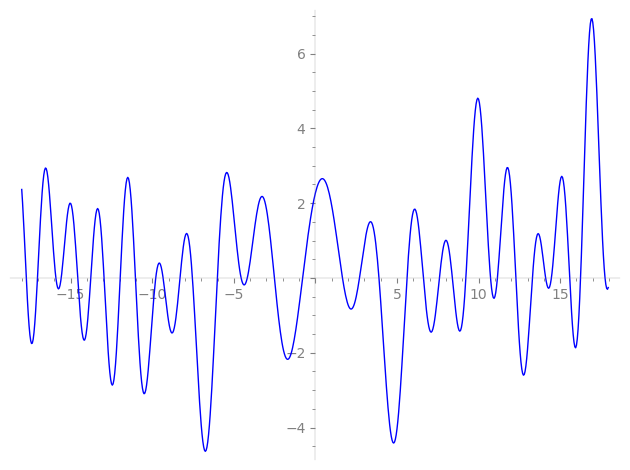| L(s) = 1 | + (3.64 + 3.64i)3-s + (−0.725 − 11.1i)5-s + (9.23 − 9.23i)7-s − 0.451i·9-s + 29.0i·11-s + (22.1 − 22.1i)13-s + (38.0 − 43.2i)15-s + (−68.5 − 68.5i)17-s + 46.3·19-s + 67.3·21-s + (−82.3 − 82.3i)23-s + (−123. + 16.1i)25-s + (100. − 100. i)27-s − 110. i·29-s − 250. i·31-s + ⋯ |
| L(s) = 1 | + (0.701 + 0.701i)3-s + (−0.0649 − 0.997i)5-s + (0.498 − 0.498i)7-s − 0.0167i·9-s + 0.796i·11-s + (0.473 − 0.473i)13-s + (0.654 − 0.745i)15-s + (−0.978 − 0.978i)17-s + 0.559·19-s + 0.699·21-s + (−0.746 − 0.746i)23-s + (−0.991 + 0.129i)25-s + (0.712 − 0.712i)27-s − 0.705i·29-s − 1.44i·31-s + ⋯ |
\[\begin{aligned}\Lambda(s)=\mathstrut & 320 ^{s/2} \, \Gamma_{\C}(s) \, L(s)\cr =\mathstrut & (0.579 + 0.814i)\, \overline{\Lambda}(4-s) \end{aligned}\]
\[\begin{aligned}\Lambda(s)=\mathstrut & 320 ^{s/2} \, \Gamma_{\C}(s+3/2) \, L(s)\cr =\mathstrut & (0.579 + 0.814i)\, \overline{\Lambda}(1-s) \end{aligned}\]
Particular Values
| \(L(2)\) |
\(\approx\) |
\(2.274203137\) |
| \(L(\frac12)\) |
\(\approx\) |
\(2.274203137\) |
| \(L(\frac{5}{2})\) |
|
not available |
| \(L(1)\) |
|
not available |
\(L(s) = \displaystyle \prod_{p} F_p(p^{-s})^{-1} \)
| $p$ | $F_p(T)$ |
|---|
| bad | 2 | \( 1 \) |
| 5 | \( 1 + (0.725 + 11.1i)T \) |
| good | 3 | \( 1 + (-3.64 - 3.64i)T + 27iT^{2} \) |
| 7 | \( 1 + (-9.23 + 9.23i)T - 343iT^{2} \) |
| 11 | \( 1 - 29.0iT - 1.33e3T^{2} \) |
| 13 | \( 1 + (-22.1 + 22.1i)T - 2.19e3iT^{2} \) |
| 17 | \( 1 + (68.5 + 68.5i)T + 4.91e3iT^{2} \) |
| 19 | \( 1 - 46.3T + 6.85e3T^{2} \) |
| 23 | \( 1 + (82.3 + 82.3i)T + 1.21e4iT^{2} \) |
| 29 | \( 1 + 110. iT - 2.43e4T^{2} \) |
| 31 | \( 1 + 250. iT - 2.97e4T^{2} \) |
| 37 | \( 1 + (-190. - 190. i)T + 5.06e4iT^{2} \) |
| 41 | \( 1 - 386.T + 6.89e4T^{2} \) |
| 43 | \( 1 + (-215. - 215. i)T + 7.95e4iT^{2} \) |
| 47 | \( 1 + (-258. + 258. i)T - 1.03e5iT^{2} \) |
| 53 | \( 1 + (313. - 313. i)T - 1.48e5iT^{2} \) |
| 59 | \( 1 - 195.T + 2.05e5T^{2} \) |
| 61 | \( 1 + 423.T + 2.26e5T^{2} \) |
| 67 | \( 1 + (-598. + 598. i)T - 3.00e5iT^{2} \) |
| 71 | \( 1 - 993. iT - 3.57e5T^{2} \) |
| 73 | \( 1 + (-22.8 + 22.8i)T - 3.89e5iT^{2} \) |
| 79 | \( 1 + 612.T + 4.93e5T^{2} \) |
| 83 | \( 1 + (176. + 176. i)T + 5.71e5iT^{2} \) |
| 89 | \( 1 + 1.25e3iT - 7.04e5T^{2} \) |
| 97 | \( 1 + (-269. - 269. i)T + 9.12e5iT^{2} \) |
| show more | |
| show less | |
\(L(s) = \displaystyle\prod_p \ \prod_{j=1}^{2} (1 - \alpha_{j,p}\, p^{-s})^{-1}\)
Imaginary part of the first few zeros on the critical line
−11.02984853717065500674033336275, −9.786417479743068934250502961026, −9.335166132747581466815941419401, −8.298283148455873575985263613394, −7.53852080735189352099076939174, −6.01330821188536669630912653949, −4.55241897392027970788996343315, −4.17710400499760866976728509049, −2.51283012484206707701673662497, −0.78591567772780696065183943770,
1.65923132584801241575092510416, 2.70062286370050241903603096983, 3.89570627866280385787465046190, 5.61118556399406839006541417891, 6.61804829273995124116081831120, 7.60001845563561938054616218692, 8.394046672759563061787947362274, 9.221516128585715981960469964097, 10.73473555964748329701690308755, 11.15557298321290320576891437447

